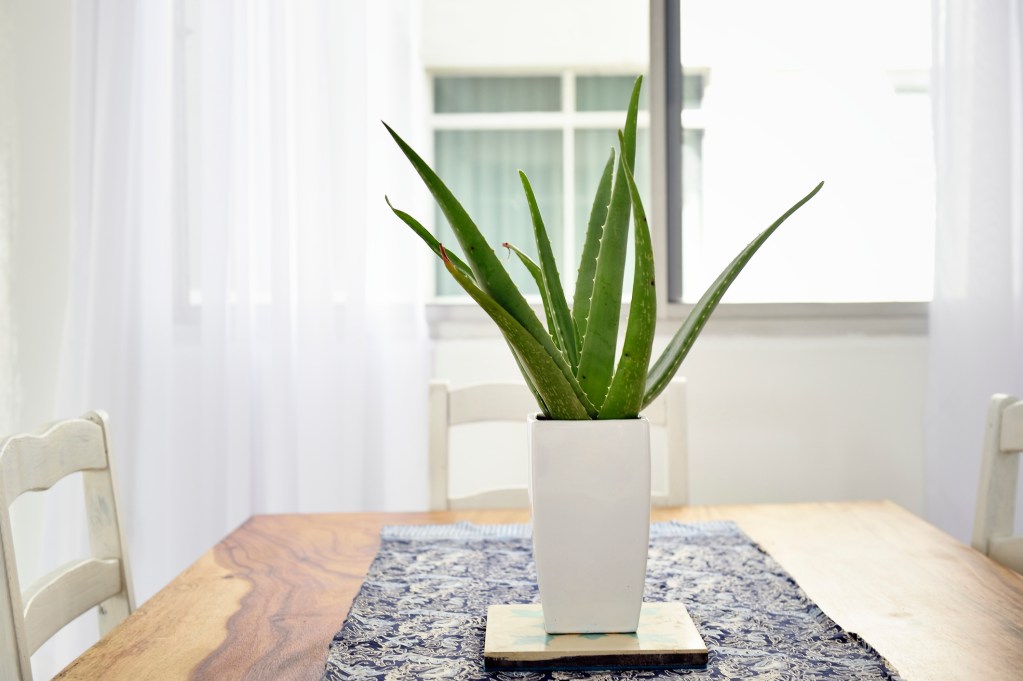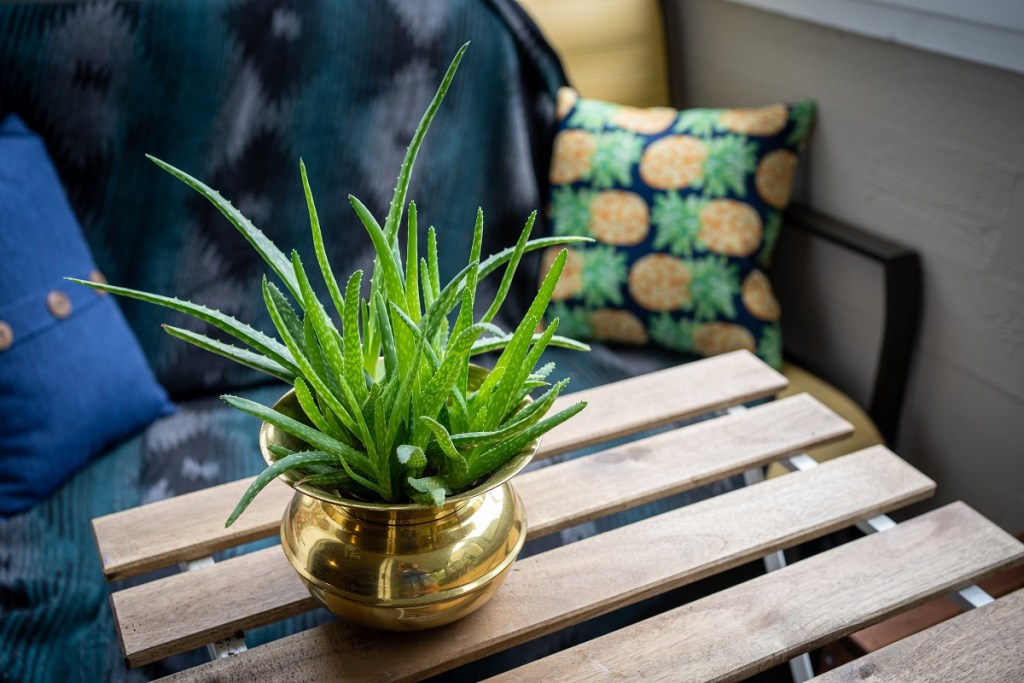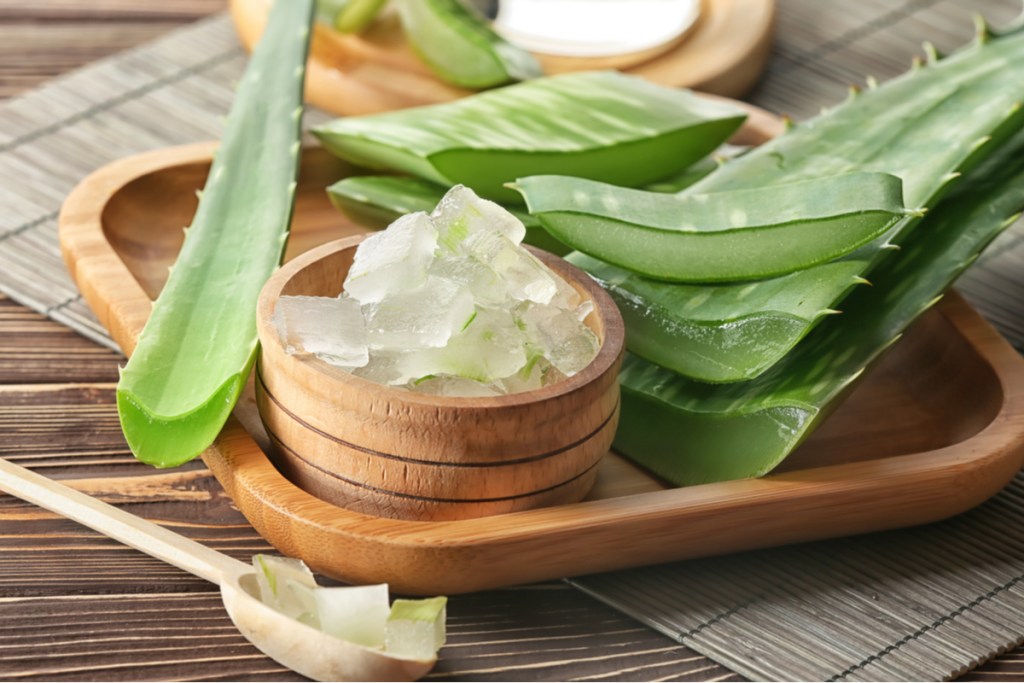Aloe vera is a well-loved plant for its healing properties and you can find it in most plant nurseries with other succulents. Another pro? It’s relatively easy to grow both outdoors and indoors. If you’re going down the latter route and keeping it as a houseplant, you will want to keep a few things in mind as you grow it. Learn all about how to care for aloe vera indoors by reading more below.

What is aloe vera?
Aloe vera is a short-stemmed shrub that belongs to the genus Aloe, which features more than 500 flowering succulents. It does well in hot, dry climates and can be found in subtropical regions globally. Aloe vera has a short rosette shape and fleshy, serrated leaves with light spots. Hardy in zones 8 through 11, it can put out yellow or orange tubular blooms and seeds during the growing season.
What are the benefits of aloe vera?
Aloe vera has been used for medicinal purposes since ancient times — the first record of its use for humans comes from Egypt in the 16th century B.C. One of the most beneficial parts of this ubiquitous succulent is its clear inner gel, which features antioxidants and anti-inflammatory properties.
Many skincare products incorporate aloe vera for its soothing properties, and it’s a popular item used for minor sunburns. It’s also used to treat skin conditions, such as dryness, psoriasis, and eczema. You can even drink aloe vera juice, which may have digestive benefits.

How do you care for an indoor aloe plant?
If you’re looking to reap the healing benefits of this versatile succulent, it’s not very tricky to grow. Aloe vera can thrive both outdoors and indoors. But given the environmental limits of growing a succulent indoors, there are a few factors to consider for aloe vera indoor plant care.
Where should I put the aloe vera plant in my house?
For aloe vera plant care indoors, you should give your plant the most light possible, which means around 6 to 8 hours a day. Put it in a south- or west-facing window to give it the most light, and you can supplement limited natural light with grow lights. But keep in mind that aloe vera plants can experience burns with too much light exposure. If your aloe vera plant turns brown or red, place it further away from your window. Consider using sheer curtains to reduce the light intensity that your plant receives.
Besides its lighting needs, the aloe vera isn’t a particularly tricky plant. It thrives in temperatures between 50 to 80 degrees Fahrenheit, so room temperature should be just right for it. Although a must for many houseplants, humidity isn’t a requirement for aloe vera, so you can leave your plant in a dry area of your home.
How often do you water an aloe plant inside?
An aloe vera plant stores water inside its fleshy leaves, so it doesn’t need a lot of watering. Because your indoor aloe vera plant will experience cooler temperatures and less light inside, it’ll probably need even less watering than if it were planted outside.
Your watering cadence may be every two or three weeks, depending on when your aloe vera dries out. Ideally, the first 1 or 2 inches of soil should feel dry when you plan on watering your plant. The rule of thumb is to water your aloe vera plant deeply instead of frequently.
What kind of soil does an indoor aloe vera plant need?
Drainage is a must for an aloe vera plant. When keeping it indoors, you generally want to avoid using garden soil, which holds onto water longer and has a heavier texture. Excessive water retention can be problematic because it makes your plant more susceptible to root rot.
An aloe vera in a container will do well with gritty, well-draining soil — the easiest way to get this is by using ready-to-go succulent and cactus soil. You can also create your own growing medium by mixing sand, pumice, perlite, bark, and coconut coir.
So, do you need to fortify your soil often? Aloe vera plants aren’t heavy feeders. They’re adapted to nutrient-poor desert soils in their natural habitats. If your succulent potting mix already has fertilizer, you won’t need to feed your plant. Fertilizer can, however, be beneficial for potted aloe veras. Throughout the growing season, use a liquid succulent food formula or a one with a 10-40-10 N-P-K ratio every month.

How to collect aloe vera gel
Collecting aloe vera gel is easy. All you have to do is cut a grown outer leaf. After separating your leaf, place it on a cutting board with the rounded side up. Then, use a knife to peel the skin around the edges and harvest the gel inside.
The aloe vera is full of healing properties and is relatively easy to track down. Even better, those without outdoor growing space can easily keep it as an indoor plant. As long as you give it gravelly, well-draining soil and take care not to overwater it, you can harvest its soothing gel soon enough.
Editors' Recommendations
- Stunning Monstera plants that you should add to your indoor plant collection
- Beyond basil and cilantro, add these unique plants to your indoor herb garden
- 5 easy-care spider plant varieties perfect for any home garden
- Easy hoya plants to add to your indoor plant collection
- Do ZZ plants cause cancer? Here’s the definitive answer




